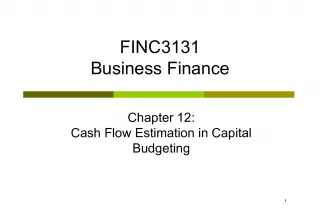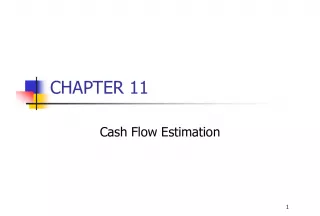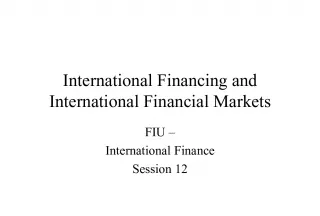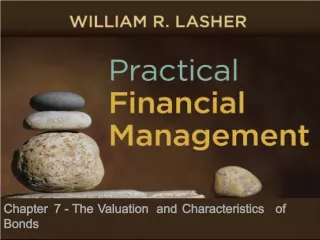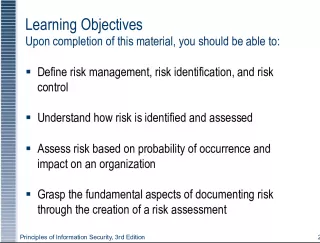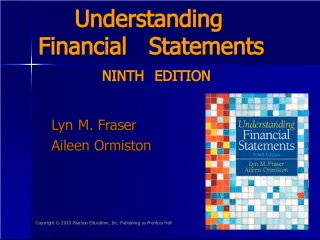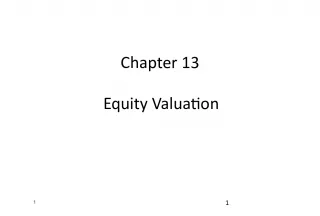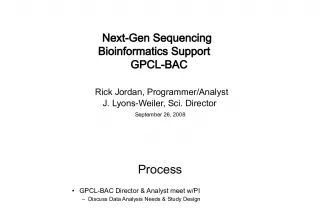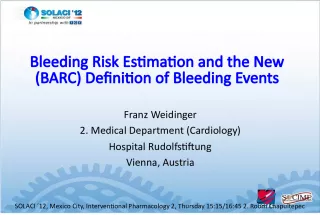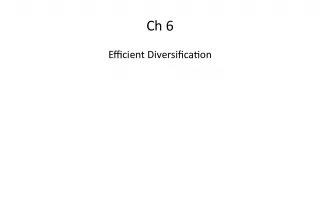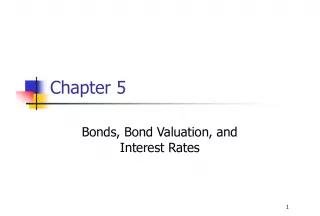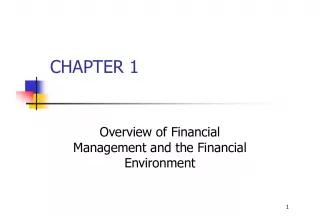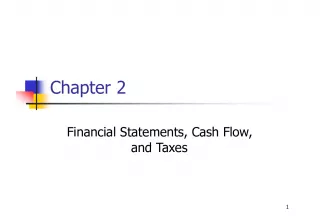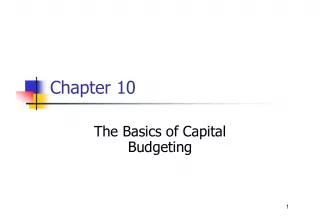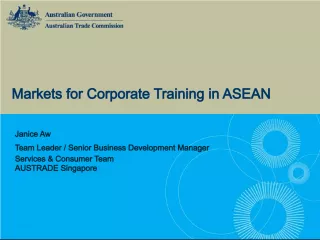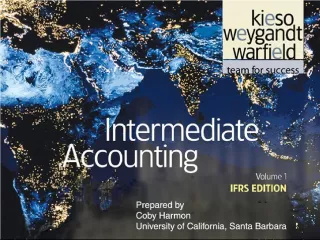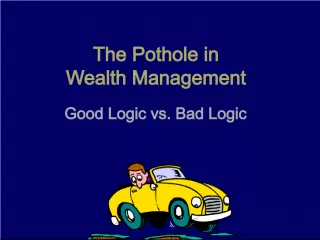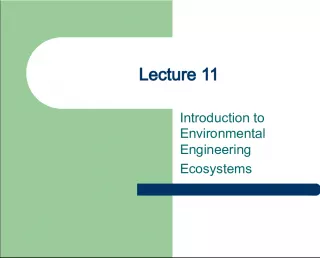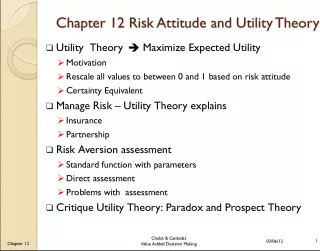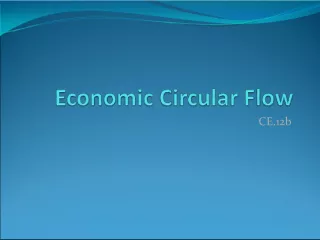Cash Flow Estimation and Risk Analysis in Corporate Valuation
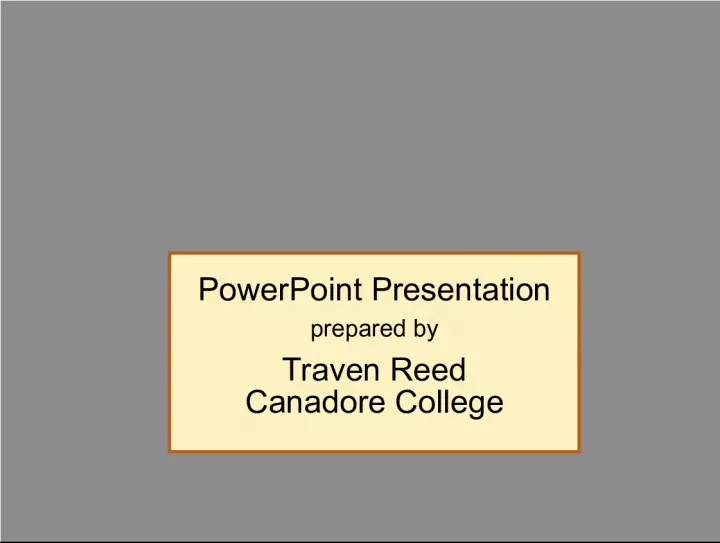

This PowerPoint presentation by Traven Reed from Canadore College focuses on the estimation of cash flows, relevant cash flows, capital cost allowance, working capital treatment, inflation, and capital budgeting with risk issues. It also covers project risk analysis and managing risk with staged decisions.
- Uploaded on | 0 Views
-
 zenitakoepp
zenitakoepp
About Cash Flow Estimation and Risk Analysis in Corporate Valuation
PowerPoint presentation about 'Cash Flow Estimation and Risk Analysis in Corporate Valuation'. This presentation describes the topic on This PowerPoint presentation by Traven Reed from Canadore College focuses on the estimation of cash flows, relevant cash flows, capital cost allowance, working capital treatment, inflation, and capital budgeting with risk issues. It also covers project risk analysis and managing risk with staged decisions.. The key topics included in this slideshow are cash flow estimation, risk analysis, corporate valuation, relevant cash flows, capital budgeting,. Download this presentation absolutely free.
Presentation Transcript
1. PowerPoint Presentation prepared by Traven Reed Canadore College
2. chapter 11 Cash Flow Estimation and Risk Analysis
3. CH11 Copyright 2011 by Nelson Education Ltd. All rights reserved. 11-3 Corporate Valuation, Cash Flows, and Risk Analysis
4. CH11 Copyright 2011 by Nelson Education Ltd. All rights reserved. 11-4 Topics in Chapter Estimating cash flows: Relevant cash flows Capital cost allowance Working capital treatment Inflation Capital budgeting with risk issues Project risk analysis Managing risk with staged-decision
5. CH11 Estimating Cash Flows The most important and also most difficult step in analyzing a capital budgeting project is the project cash-flow estimation. Project cash flows mean actual cash to be received or paid. Credit policy is invariably ignored in the capital budgeting process. Copyright 2011 by Nelson Education Ltd. All rights reserved. 11-5
6. CH11 Relevant Cash Flows Additional free cash flow that firms can expect if they implement the project. Only incremental amounts are considered. FCF/NCF = investment outlay CF + operating CF + net operating working capital CF + salvage CF Copyright 2011 by Nelson Education Ltd. All rights reserved. 11-6
7. CH11 Capital Cost Allowance (CCA) Income Tax Act (ITA) does allow firms to deduct CCA, which is similar to amortization for book purposes, in calculating taxable income. CCA calculation is similar to declining balance amortization for most assets. A non-cash expenses involving no actual cash outflow. Have deep cash flow implications. Copyright 2011 by Nelson Education Ltd. All rights reserved. 11-7
8. CH11 CCA (Contd) Apply to tangible assets based on CCA class specification. Pool concept, not concerned with the economic life and salvage value of any individual asset. Un-depreciated capital cost (UCC) is the amount remaining to be claimed (i.e. book value) as CCA for an asset class. UCC market value in general. Copyright 2011 by Nelson Education Ltd. All rights reserved. 11-8
9. CH11 Effect of CCA Depreciation on Income and Cash Flow Company A Company B Sales $100,000 $100,000 Cost of good sold 30,000 30,000 Gross profit $70,000 $70,000 Operating expenses 50,000 50,000 Depreciation (CCA) 0 10,000 Earning before tax $20,000 $10,000 Tax @30% 6,000 3,000 Net income $14,000 $7,000 + Depreciation 0 10,000 Cash flow $14,000 $17,000 Copyright 2011 by Nelson Education Ltd. All rights reserved. 11-9
10. CH11 Common Asset Classes CCA tax shield = CCA tax rate Copyright 2011 by Nelson Education Ltd. All rights reserved. 11-10 Class Description CCA Rate 1 Buildings 4% 8 Machinery, equipment, furniture 20% 10 Vehicles 30% 12 Computer software 100% 13 Leasehold improvements Straight line; use lesser of 5 years or the lease term 43 Manufacturing assets 30% 45 Computer hardware 45%
11. CH11 CCA Calculation Half-year rule allows to include just one- half of the asset purchase cost for CCA calculation in the year it is bought. This rule is to discourage the last minute purchase. Regardless when the asset is actually purchased, deduction is the same. The remaining half of the purchase cost is added to the asset class in the subsequent year. Copyright 2011 by Nelson Education Ltd. All rights reserved. 11-11
12. CH11 CCA Calculation (contd) If net asset acquisition (purchases > sales) is positive, the half-year rule applies (a) . Copyright 2011 by Nelson Education Ltd. All rights reserved. 11-12 Year Bgn. UCC Add/Disp Sales Proceeds UCC before CCA CCA @30% 2006 $0 $30,000 -- $30,000 $4,500 2007 $25,500 -- -- $25,500 $7,650 2008 $17,850 $40,000 --- $57,850 $11,355 2009 $46,495 $12,000 $10,000 (a) $48,495 $14,249 $12,000 $20,000 (b) $38,495 $11,549
13. CH11 CCA Remarks Half-year rule does not apply to CCA calculations when there is a net capital asset disposition (b) Adjusted cost of disposal = min [original cost, sales proceeds] Finding the present value of CCA tax shield is the concern In principle, tax savings from CCA go on even when the project in question ends Copyright 2011 by Nelson Education Ltd. All rights reserved. 11-13
14. CH11 Taxation for Sales/Purchases of Assets Recapture occurs when the sale of an asset creates a negative UCC balance. CCA recapture is fully taxable. Terminal loss arises when the asset pool is closed, but the UCC is still positive after selling the last item. Loss may be deducted from income. Capital gain exists when the asset is sold for more than its initial cost. Gains are taxed at 50%. Copyright 2011 by Nelson Education Ltd. All rights reserved. 11-14
15. CH11 Copyright 2011 by Nelson Education Ltd. All rights reserved. 11-15 Proposed Expansion Project $200,000 cost + $10,000 shipping + $30,000 installation. Economic life = 4 years Salvage value = $25,000 CCA class 43 with a 30% rate
16. CH11 Copyright 2011 by Nelson Education Ltd. All rights reserved. 11-16 Project Input Data Annual unit sales = 1,250 Unit sales price = $200 Unit costs = $100 Net operating working capital (NOWC) = 12% of sales. Tax rate = 40% Project cost of capital = 10% Inflation = 3%
17. CH11 Copyright 2011 by Nelson Education Ltd. All rights reserved. 11-17 What is the depreciation basis? Depreciation basis is the capital cost of the asset established for CCA calculation Basis = Cost + Shipping + Installation = $240,000 Annual CCA deduction = Applicable UCC CCA rate
18. CH11 Copyright 2011 by Nelson Education Ltd. All rights reserved. 11-18 Annual Depreciation Expense (000s) Year % X (Initial Basis) = Depr. 1 0.30 $240 $72.0 2 0.30 50.4 3 0.30 35.28 4 0.30 24.696
19. CH11 Copyright 2011 by Nelson Education Ltd. All rights reserved. 11-19 Annual Sales and Costs Year 1 Year 2 Year 3 Year 4 Units 1250 1250 1250 1250 Unit Price $200 $206 $212.18 $218.55 Unit Cost $100 $103 $106.09 $109.27 Sales $250,000 $257,500 $265,225 $273,188 Costs $125,000 $128,750 $132,613 $136,588
20. CH11 Copyright 2011 by Nelson Education Ltd. All rights reserved. 11-20 Operating Cash Flows (Years 1 and 2) Year 1 Year 2 Sales $250,000 $257,500 Costs $ 125,000 $ 128,750 EBIT $125,000 $128,750 Taxes (40%) $50,000 $51,500 Op. CF $75,000 $77,250 + CCA Tax Shield $14,400 $24,480 Net Op. $60,600 $52,770
21. CH11 Copyright 2011 by Nelson Education Ltd. All rights reserved. 11-21 Operating Cash Flows (Years 3 and 4) Year 3 Year 4 Sales $265,225 $273,188 Costs $ 132,613 $ 136,588 EBIT $132,612 $136,588 Taxes (40%) $53,045 $54,635 Op. CF $79,567 $81,953 + CCA Tax Shield $17,136 $ 5,141 Net Op. $62,431 $76,812
22. CH11 Copyright 2011 by Nelson Education Ltd. All rights reserved. 11-22 Cash Flows due to Investments in Net Operating Working Capital (NOWC) Sales NOWC (12% of sales) CF Due to Investment in NOWC Year 0 $30,000 -$30,000 Year 1 $250,000 $30,900 -$900 Year 2 $257,500 $31,827 -$927 Year 3 $265,225 $32,783 -$956 Year 4 $273,188 $0 $32,783
23. CH11 Copyright 2011 by Nelson Education Ltd. All rights reserved. 11-23 Salvage Cash Flow at t = 4 (000s) Salvage Value $25 Book Value (Assume full depreciation) 0 Gain or loss $25 Tax (40%) on SV 10 Net Terminal CF $15
24. CH11 Copyright 2011 by Nelson Education Ltd. All rights reserved. 11-24 Net Cash Flows for Years 1-3 Year 0 Year 1 Year 2 Init. Cost -$240,000 0 0 Op. CF 0 $60,600 $52,770 NOWC CF -$30,000 -$900 -$927 Salvage CF 0 0 0 Net CF -$270,000 $59,700 $51,843
25. CH11 Copyright 2011 by Nelson Education Ltd. All rights reserved. 11-25 Net Cash Flows for Years 4-5 Year 3 Year 4 Init. Cost 0 0 Op. CF $62,431 $76,812 NOWC CF -$956 $32,783 Salvage CF 0 $15,000 Net CF $61,475 $124,595
26. CH11 Copyright 2011 by Nelson Education Ltd. All rights reserved. 11-26 Enter CFs in the register and I = 10. NPV = -$41,595 < 0, reject. 0 1 2 3 4 (270,000) 59,700 51,843 61,475 124,595 Project Net CFs on a Time Line
27. CH11 Copyright 2011 by Nelson Education Ltd. All rights reserved. 11-27 (270,000) MIRR = ? 0 1 2 3 4 (270,000) 59,700 51,843 61,475 124,595 67,623 62,730 79,461 334,409 Use MIRR to double check the proposed project
28. CH11 Copyright 2011 by Nelson Education Ltd. All rights reserved. 11-28 Calculator Solution Enter positive CFs in CFLO. Enter I = 10. Solve for NPV = $228,405 Now use TVM keys: PV = -228,405, N = 4, I = 10; PMT = 0; Solve for FV = 334,409 (This is total of inflows) Use TVM keys: N = 4; FV = 334,409; PV = -270,000; PMT= 0; Solve for I = ? I = 5.49% < 10% (WACC project ), reject.
29. CH11 Determining Project Cash Flows Free (or net) cash flows from operation may increase because operating sales increase, operating costs decrease, or both occur FCF/NCF = EBIT Taxes + CCA deduction = Net income + CCA deduction OCF/NCF = (Sales Cash costs)(1 - T c ) + (CCA)(T c ) = cash flows from the operating project + tax savings from the CCA Find the PV of each set of CFs independently, and add them to get the NPV. PVTS calculation is tedious.
30. CH11 PV of the CCA tax shield The formula offers a one-step solution instead of finding separately for each years PV from the CCA tax shield. PV of CCA tax shield: The setup assumes the asset class remains open after the asset is sold (i.e. UCC > 0). Copyright 2011 by Nelson Education Ltd. All rights reserved. 11-30
31. CH11 PVTS Formula: Interpretation (1) calculates the total PV of the tax shield assuming the asset is held in perpetuity (2) accounts for the half-year rule (3) discounts the lost tax shield to the present time (4) calculates the PV (at time of sale) of the tax shield given up from selling the asset Copyright 2011 by Nelson Education Ltd. All rights reserved. 11-31
32. CH11 PV (CCA Tax Shield) Computational Formula Copyright 2011 by Nelson Education Ltd. All rights reserved. 11-32 C = $8,000 = capital cost of the asset d = 30% = CCA rate of the asset class T c = 30% = corporate tax rate r = 12% = discount rate S = $2,000 = salvage value of the asset PVTS = $1,350
33. CH11 Change in Net Operating Working Capital ( NOWC) The difference between the change in current assets and current liabilities associated with a project NOWC = CA CL > or < 0 Changes in new working capital merely involve the net build-up or reduction of current accounts All changes will be reverted by the end of the projects life.
34. CH11 NOWC: Example A/R: $150;$170 =$20 (addition) Inventory:$278;$325 =$47 (addition) A/P: $250;$221 =-$29 (addition) NOWC = CA - CL = [(A/R)+(Inv)]- [(A/P)] = [(20+ 47)] (-29) = $96 We need an extra investment of $96 in order to get this project running
35. CH11 Copyright 2011 by Nelson Education Ltd. All rights reserved. 11-35 Treatment of Financing Costs Should you subtract interest expense or dividends when calculating CF? NO. We discount project cash flows with a cost of capital that is the rate of return required by all investors (not just debtholders or stockholders), and so we should discount the total amount of cash flow available to all investors. They are part of the costs of capital. If we subtracted them from cash flows, we would be double counting capital costs.
36. CH11 Copyright 2011 by Nelson Education Ltd. All rights reserved. 11-36 Sunk Costs Suppose $100,000 had been spent last year to improve the production line site. Should this cost be included in the analysis? NO. This is a sunk cost. Focus on incremental investment and operating cash flows.
37. CH11 Copyright 2011 by Nelson Education Ltd. All rights reserved. 11-37 Opportunity Costs Suppose the plant space could be leased out for $25,000 a year. Would this affect the analysis? Yes. Accepting the project means we will not receive the $25,000. This is an opportunity cost and it should be charged to the project. After-tax opportunity cost = $25,000 (1 - T) = $15,000 annual cost.
38. CH11 Externalities If the new product line would decrease sales of the firms other products by $50,000 per year, would this affect the analysis? Yes. The effects on the other projects CFs are externalities. Net CF loss per year on other lines would be a cost to this project. Externalities will be positive if new projects are complements to existing assets, negative if substitutes. Copyright 2011 by Nelson Education Ltd. All rights reserved. 11-38
39. CH11 Incremental CF for a Project A replacement project occurs when the firm replaces an existing asset with a new one. Projects incremental cash flow = (corporate cash flow with the project) (corporate cash flow without the project) Copyright 2011 by Nelson Education Ltd. All rights reserved. 11-39
40. CH11 Timing of CF In theory, CFs should be analyzed exact as they occur due to the TVM In practice, we cannot afford such degree of detail In general, although we assume all CFs occur at the end of every year. we may need to estimate mid-year, quarterly or monthly CFs. Copyright 2011 by Nelson Education Ltd. All rights reserved. 11-40
41. CH11 Copyright 2011 by Nelson Education Ltd. All rights reserved. 11-41 Why is it important to include inflation when estimating cash flows? Nominal r > real r. The cost of capital, r, includes a premium for inflation. Nominal CF > real CF. This is because nominal cash flows incorporate inflation. If you discount real CF with the higher nominal r, then your NPV estimate is too low.
42. CH11 Copyright 2011 by Nelson Education Ltd. All rights reserved. 11-42 Inflation (contd) Nominal CF should be discounted with nominal r, and real CF should be discounted with real r. Practically, it is more realistic to find the nominal CF (i.e., increase cash flow estimates with inflation) than it is to reduce the nominal r to a real r.
43. CH11 Inflation Adjustment Nominal CF t = Real CF t (1 + i) t Fisher equation: (1+r NOM ) = (1+ r r ) (1 + i) NPV(with inflation): No inflation: Copyright 2011 by Nelson Education Ltd. All rights reserved. 11-43
44. CH11 Copyright 2011 by Nelson Education Ltd. All rights reserved. 11-44 What does risk mean in capital budgeting? Uncertainty about a projects future profitability. Measured by NPV , IRR , beta. Will taking on the project increase the firms and stockholders risk?
45. CH11 Copyright 2011 by Nelson Education Ltd. All rights reserved. 11-45 Is risk analysis based on historical data or subjective judgment? Can sometimes use historical data, but generally cannot. So risk analysis in capital budgeting is usually based on subjective judgments.
46. CH11 Copyright 2011 by Nelson Education Ltd. All rights reserved. 11-46 What three types of risk are relevant in capital budgeting? Stand-alone risk Corporate risk Market (or beta) risk They are highly correlated - if the general economy does well, so will the firm, and it the firm does well, so will most of its projects.
47. CH11 Copyright 2011 by Nelson Education Ltd. All rights reserved. 11-47 Stand-Alone Risk The projects risk if it were the firms only asset and there were no shareholders. Ignores both firm and shareholder diversification. Measured by the or CV of NPV, IRR, or MIRR.
48. CH11 Copyright 2011 by Nelson Education Ltd. All rights reserved. 11-48 0 E(NPV) Flatter distribution, larger , larger stand-alone risk. NPV Probability Density
49. CH11 Copyright 2011 by Nelson Education Ltd. All rights reserved. 11-49 Corporate Risk Reflects the projects effect on corporate earnings stability. Considers firms other assets (diversification within firm). Depends on projects , and its correlation, , with returns on firms other assets. Measured by the projects corporate beta.
50. CH11 Copyright 2011 by Nelson Education Ltd. All rights reserved. 11-50 Profitability 0 Years Project X Total Firm Rest of Firm Project X is negatively correlated to firms other assets, so has big diversification benefits. If r = 1.0, no diversification benefits. If r < 1.0, some diversification benefits.
51. CH11 Copyright 2011 by Nelson Education Ltd. All rights reserved. 11-51 Market Risk Reflects the projects effect on a well-diversified stock portfolio. Takes account of stockholders other assets. Depends on projects and correlation with the stock market. Measured by the projects market beta.
52. CH11 Copyright 2011 by Nelson Education Ltd. All rights reserved. 11-52 How is each type of risk used? Market risk is theoretically best in most situations. However, creditors, customers, suppliers, and employees are more affected by corporate risk. Therefore, corporate risk is also relevant.
53. CH11 Copyright 2011 by Nelson Education Ltd. All rights reserved. 11-53 Stand-alone risk is easiest to measure, more intuitive. Core projects are highly correlated with other assets, so stand-alone risk generally reflects corporate risk. If the project is highly correlated with the economy, stand-alone risk also reflects market risk. How is each type of risk used? (contd)
54. CH11 Copyright 2011 by Nelson Education Ltd. All rights reserved. 11-54 Sensitivity Analysis Shows how changes in a variable such as unit sales affect NPV or IRR. Each variable is fixed except one. Change this one variable to see the effect on NPV or IRR. Answers what if questions, e.g. What if sales decline by 30%?
55. CH11 Copyright 2011 by Nelson Education Ltd. All rights reserved. 11-55 Evaluating Risk: Sensitivity Graph
56. CH11 Copyright 2011 by Nelson Education Ltd. All rights reserved. 11-56 Results of Sensitivity Analysis Steeper sensitivity lines show greater risk. Small changes result in large declines in NPV. Unit sales line is steeper than salvage value or r, so for this project, should worry most about accuracy of sales forecast.
57. CH11 Copyright 2011 by Nelson Education Ltd. All rights reserved. 11-57 What are the weaknesses of sensitivity analysis? Does not reflect diversification. Says nothing about the likelihood of change in a variable, i.e. a steep sales line is not a problem if sales wont fall. Ignores relationships among variables.
58. CH11 Copyright 2011 by Nelson Education Ltd. All rights reserved. 11-58 Why is sensitivity analysis useful? Gives some idea of stand-alone risk. Identifies dangerous variables. Gives some breakeven information.
59. CH11 Copyright 2011 by Nelson Education Ltd. All rights reserved. 11-59 Scenario Analysis Examines several possible situations, usually worst case, most likely case, and best case. Provides a range of possible outcomes.
60. CH11 Copyright 2011 by Nelson Education Ltd. All rights reserved. 11-60 Best scenario: 1,600 units @ $240 Worst scenario: 900 units @ $160 Scenario Probability NPV(000) Best 0.25 $279 Base 0.50 88 Worst .025 -49 E(NPV) = $101.5 (NPV) = 116.6 CV(NPV) = (NPV)/E(NPV) = 1.15
61. CH11 Copyright 2011 by Nelson Education Ltd. All rights reserved. 11-61 Are there any problems with scenario analysis? Only considers a few possible out- comes. Assumes that inputs are perfectly correlated--all bad values occur together and all good values occur together. Focuses on stand-alone risk, although subjective adjustments can be made.
62. CH11 Copyright 2011 by Nelson Education Ltd. All rights reserved. 11-62 Monte Carlo Simulation A computerized version of scenario analysis which uses continuous probability distributions. Computer selects values for each variable based on given probability distributions.
63. CH11 Copyright 2011 by Nelson Education Ltd. All rights reserved. 11-63 NPV and IRR are calculated. Process is repeated many times (1,000 or more). End result: Probability distribution of NPV and IRR based on sample of simulated values. Generally shown graphically. Simulation Analysis (contd)
64. CH11 Copyright 2011 by Nelson Education Ltd. All rights reserved. 11-64 Histogram of Results
65. CH11 Copyright 2011 by Nelson Education Ltd. All rights reserved. 11-65 What are the advantages of simulation analysis? Reflects the probability distributions of each input. Shows range of NPVs, the expected NPV, NPV , and CV NPV . Gives an intuitive graph of the risk situation.
66. CH11 Copyright 2011 by Nelson Education Ltd. All rights reserved. 11-66 What are the disadvantages of simulation? Difficult to specify probability distributions and correlations. If inputs are bad, output will be bad: Garbage in, garbage out.
67. CH11 Copyright 2011 by Nelson Education Ltd. All rights reserved. 11-67 Sensitivity, scenario, and simulation analyses do not provide a decision rule. They do not indicate whether a projects expected return is sufficient to compensate for its risk. Sensitivity, scenario, and simulation analyses all ignore diversification. Thus they measure only stand-alone risk, which may not be the most relevant risk in capital budgeting. Project Risk Conclusions
68. CH11 Copyright 2011 by Nelson Education Ltd. All rights reserved. 11-68 If the firms average project has a CV of 0.2 to 0.4, is this a high-risk project? What type of risk is being measured? CV from scenarios = 0.74, CV from simulation = 0.62 Both are > 0.4, this project has high risk. CV measures a projects stand- alone risk. High stand-alone risk usually indicates high corporate and market risks.
69. CH11 Copyright 2011 by Nelson Education Ltd. All rights reserved. 11-69 With a 3% risk adjustment, should our project be accepted? Project r = 10% + 3% = 13% Thats 30% above base r NPV = $65,371 Project remains acceptable after accounting for differential (higher) risk.
70. CH11 Copyright 2011 by Nelson Education Ltd. All rights reserved. 11-70 Should subjective risk factors be considered? Yes. A numerical analysis may not capture all of the risk factors inherent in the project. For example, if the project has the potential for bringing on harmful lawsuits, then it might be riskier than a standard analysis would indicate.
71. CH11 Incorporating Project Risk into Capital Budgeting Risk-adjusted discount rate (RADR) or project cost of capital is used to evaluate a particular project Each project carries different risk The corporate r WACC is based on the firms average risk project Adjust r WACC upward/downward for more/less risky projects Copyright 2011 by Nelson Education Ltd. All rights reserved. 11-71
72. CH11 Decision Trees A form of scenario analysis in which different actions are taken in different scenarios. The analysis becomes very helpful whenever new information arrives. If investment is made in stages, the flexibility improves decision making with decision tree analysis. Copyright 2011 by Nelson Education Ltd. All rights reserved. 11-72
73. CH11 Copyright 2011 by Nelson Education Ltd. All rights reserved. 11-73 Real option Real options exist when managers can influence the size and risk of a projects cash flows by taking different actions during the projects life in response to changing market conditions. Alert managers always look for real options in projects. Smarter managers try to create real options.
74. CH11 Copyright 2011 by Nelson Education Ltd. All rights reserved. 11-74 Types of real options Investment timing options Growth options Expansion of existing product line New products New geographic markets Abandonment options Contraction Temporary suspension Flexibility options
